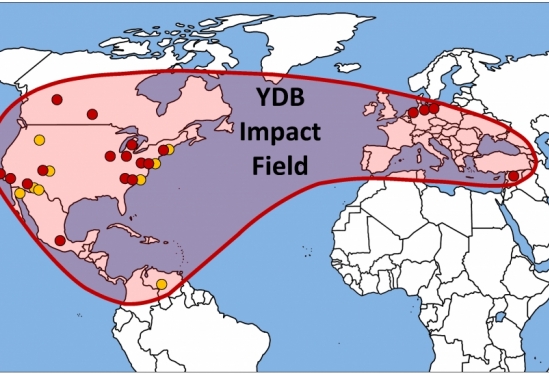
http://www.news.ucsb.edu/2013/013537/comprehensive-analysis-impact-spherules-supports-theory-cosmic-impact-12800-years-ago
One of the newer and more controversial arguments is that recent human history (the last 11,000 years) has been driven by a series of impact events. The first of which was the Younger Dryas (YD), about 10,900 years ago, which appears to be a continental class disaster centered on North America. At the time of the Younger Dryas, the earth was coming out of the last great Ice Age, and was plunges back into cold for over 1000 years. The temperature shift happened very swiftly and was coincident with extinction of large mammals in North America, giant sloths, mastodons, horses, etc. The Clovis People also disappeared about the same time. The current theory has a comet storm, literally tens of thousands of Tunguska-sized objects, raining down on North America, with impacts centered on Michigan and north central Mexico, wiping out all the larger mammals and torching the forests. The impactors are thought to be parts of a fragmented comet, the progenitor of the Taurid Complex, which entered the solar system and ended up in a short, earth crossing orbit some 20 – 30,000 years ago. Comets are notoriously fragile, with many observed fragmenting into pieces during passage through the inner solar system. Since the earth crosses the orbit of this debris stream twice a year, it is only a matter of time before it intersects regions of the stream that are thick with debris. If the initial body was sufficiently large, there would be a lot of debris. Today, the comet Encke and over 17 smaller asteroids have similar orbital elements and are thought to be part of the debris remaining from the initial object. The Tunguska object had similar orbital elements. The problem with such a theory is that there are no craters, no large obvious holes in the ground. At the time, Michigan was mostly covered with an ice sheet, though there are indications that the pounding was sufficient to beat through the ice and melt the surface via atmospheric blast effects. Some investigators point to parts of northern Mexico and the southwest US that appear to have hundreds of smaller craters and ignimbrite flows – density currents – without any evidence of volcanic activity. Last week, the latest paper on the event was published. This one tracks the discovery of microspherules, nanodiamonds and iridium – all blast and impact products – over four continents dated at the YD date. The impact footprint covers half the globe. You can find that paper and additional information at the Cosmic Tusk link at the end of this piece. One of the things that interest me about this is the notion that we still cross through the various streams of debris twice a year, and that there is still a lot of stuff out there. If real, the YD event was most certainly not the first or the last stream crossing. It may very well have been the worst though. Some investigators pouring through ancient texts believe comet impacts have driven and changed human history since the end of the last ice age, toppling civilizations. It also explains why they were so careful about comets and terrified by their appearance in the sky. This is all new and there is a lot to be discovered. But the science continues to inch along. Unlike the political fraud masquerading as manmade global warming the YD research is not (to the best of my knowledge) dependent on the public dime, which may explain its progress over the last few decades. http://cosmictusk.com/
